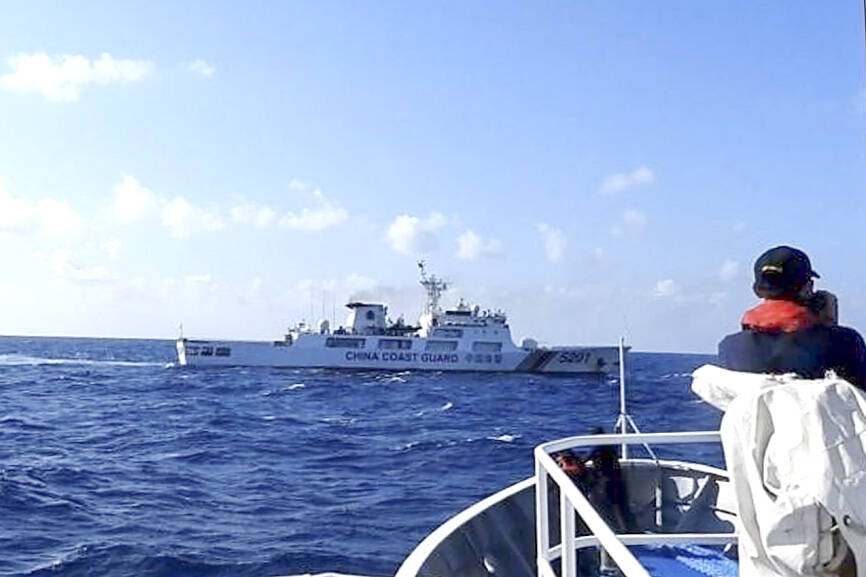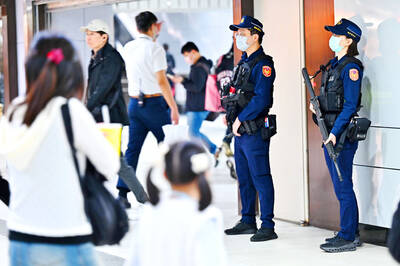The Philippine Coast Guard yesterday accused a Chinese vessel of “dangerous maneuvers” as it attempted to block Filipino scientists from reaching a reef in the South China Sea.
The incident happened onThursday near Sandy Cay (Dunqian Cay, 敦謙沙洲), several kilometers from the Philippine-held Thitu Island (Jhongye Island, 中業島) in the contested Spratly Islands (Nansha Islands, 南沙群島), where the two countries have repeatedly clashed in recent months.
Confrontations between Chinese and Philippine vessels, including collisions, in the strategic waterway have strained relations between Manila and Beijing, which have a long history of maritime territorial disputes.

Photo: Philippine Coast Guard via AP
In the latest incident, a boat belonging to the Philippine Bureau of Fisheries and Aquatic Resources was taking marine scientists to the reef when a China Coast Guard vessel crossed its path, coming as close as 100m, Philippine Coast Guard spokesman Commodore Jay Tarriela said.
Tarriela said the China Coast Guard vessel sounded a siren for more than 30 minutes to draw the attention of “Chinese maritime militia” boats in the area.
However, the China Coast Guard on Thursday said that 34 Filipinos had “illegally” landed on the reef that the Philippines calls Pagasa Cay 2.
Chinese “law enforcement officers” landed there, where they “investigated,” China Coast Guard spokesperson Gan Yu (甘羽) said in a statement.
“That’s another lie coming from the Chinese Coast Guard,” Tarriela said yesterday.
Tarriela said the scientific team spent four hours at two reefs and was able to complete its mission, despite the presence of Chinese vessels and a Chinese military helicopter circling overhead.
China claims almost the entire South China Sea, brushing off rival claims from countries including the Philippines and an international ruling that its assertion has no legal basis.
An initial assessment of Sandy Cay and a second reef near Thitu showed that the fish and corals were in a “very poor” state, University of the Philippines marine biologist Jonathan Anticamara told a news conference.
Anticamara, who led the scientific mission, said his team observed “unnatural” and “wide” piles of rubble taller than a person at Sandy Cay.
“We don’t know who put it there,” Anticamara said.
Some of the countries with overlapping claims to the Spratlys, including Taiwan, China and Vietnam, have turned reefs into artificial islands where they have built ports, airstrips and military facilities.
China’s land reclamation has outstripped other claimants, the US-based Asia Maritime Transparency Initiative (AMTI) said.
AMTI said China has carried out “unprecedented dredging and artificial island-building in the Spratlys” since 2013, creating about 1,300 hectares of new land.

TRAGEDY STRIKES TAIPEI: The suspect died after falling off a building after he threw smoke grenades into Taipei Main Station and went on a killing spree in Zhongshan A 27-year-old suspect allegedly threw smoke grenades in Taipei Main Station and then proceeded to Zhongshan MRT Station in a random killing spree that resulted in the death of the suspect and two other civilians, and seven injured, including one in critical condition, as of press time last night. The suspect, identified as a man surnamed Chang Wen (張文), allegedly began the attack at Taipei Main Station, the Taipei Fire Department said, adding that it received a report at 5:24pm that smoke grenades had been thrown in the station. One man in his 50s was rushed to hospital after a cardiac arrest

A car bomb killed a senior Russian general in southern Moscow yesterday morning, the latest high-profile army figure to be blown up in a blast that came just hours after Russian and Ukrainian delegates held separate talks in Miami on a plan to end the war. Kyiv has not commented on the incident, but Russian investigators said they were probing whether the blast was “linked” to “Ukrainian special forces.” The attack was similar to other assassinations of generals and pro-war figures that have either been claimed, or are widely believed to have been orchestrated, by Ukraine. Russian Lieutenant General Fanil Sarvarov, 56, head

SAFETY FIRST: Double the number of police were deployed at the Taipei Marathon, while other cities released plans to bolster public event safety Authorities across Taiwan have stepped up security measures ahead of Christmas and New Year events, following a knife and smoke bomb attack in Taipei on Friday that left four people dead and 11 injured. In a bid to prevent potential copycat incidents, police deployments have been expanded for large gatherings, transport hubs, and other crowded public spaces, according to official statements from police and city authorities. Taipei Mayor Chiang Wan-an (蔣萬安) said the city has “comprehensively raised security readiness” in crowded areas, increased police deployments with armed officers, and intensified patrols during weekends and nighttime hours. For large-scale events, security checkpoints and explosives

PUBLIC SAFETY: The premier said that security would be tightened in transport hubs, while President Lai commended the public for their bravery The government is to deploy more police, including rapid response units, in crowded public areas to ensure a swift response to any threats, President William Lai (賴清德) said yesterday after a knife attack killed three people and injured 11 in Taipei the previous day. Lai made the remarks following a briefing by the National Police Agency on the progress of the investigation, saying that the attack underscored the importance of cooperation in public security between the central and local governments. The attack unfolded in the early evening on Friday around Taipei Main Station’s M7 exit and later near the Taipei MRT’s Zhongshan